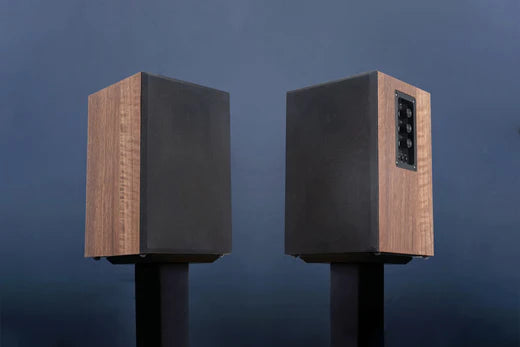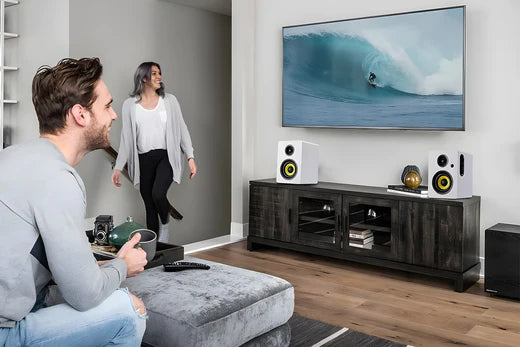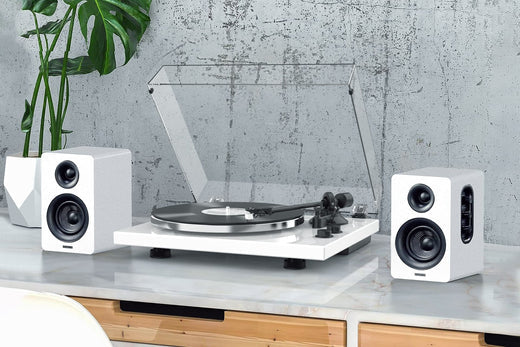Introduction
Speakers are the core component of a sound system, and their performance is affected by a number of specifications. However, to many audiophiles, these specs seem filled with technical jargon and mystery. In this in-depth blog post, we’ll take a deep dive into speaker specs, explaining what each parameter means and how to understand these specs to better select and optimize your sound system.
Part 1 - Frequency Response
1) The concept of frequency response:
Frequency response refers to the ability of a speaker to produce sound in different frequency ranges. It is usually presented in the form of a graph or chart that shows the intensity of the sound output of the speaker at various frequencies. Frequency response usually includes two main aspects:
- High-frequency response: This refers to a speaker's performance in the high audio range, which typically includes mid-treble and treble. High-frequency response determines the clarity and detail of a speaker, as well as its ability to reproduce high frequencies.
- Low Frequency Response: This indicates the speaker's performance in the low audio range, including mid-bass and bass. Low-frequency response affects a speaker's bass depth and power, as well as its ability to produce rich bass.
2) How to read a frequency response graph:
Frequency response charts typically represent frequency (measured in Hertz, Hz) on the horizontal axis and relative intensity of sound output (usually measured in decibels (dB)) on the vertical axis. Here are some examples:
- A flat curve means that the sound output of the speaker is basically equal at each frequency.
- A rising curve indicates that the speaker has stronger sound output in the high frequency range, possibly with more treble.
- A declining curve indicates that the speaker has weaker sound output in the high frequency range and may lack treble.
- Peaks or valleys at a specific frequency indicate that the speaker's sound output at that frequency is unusually strong or weak.
3) The relationship between frequency response and speaker performance:
- Sound Quality: A flat frequency response is generally considered ideal because it means the speaker is able to reproduce sound across frequencies in a relatively even manner, providing clear, accurate sound quality.
- Type of music: Frequency response can affect the type of music a speaker is suitable for. For example, jazz and classical music often require a wider frequency range, while pop music may focus more on bass and treble.
- Choose speakers that suit your needs: Knowing the frequency response of your speakers can help you choose speakers that suit your needs. If you like bass-heavy music, it may be more appropriate to choose a speaker with stronger low-frequency response. If you're looking for treble clarity, speakers that focus on high-frequency response may be more suitable.
To sum up, understanding the frequency response of a speaker is one of the key factors in choosing a speaker, because it directly affects the sound quality and applicable scenarios of the speaker. Depending on your musical tastes and needs, choosing speakers with the appropriate frequency response will help you get the best sound experience.
Part 2 - Impedance
1) What is the impedance of the speaker:
Impedance refers to the degree of obstruction of the speaker to the flow of current, usually expressed in ohms (symbol Ω). In the audio system, the impedance of the speaker is an important electrical parameter, which represents the resistance of the speaker to current at different frequencies. It is measured on the terminals of the speaker and is usually marked with the speaker's technical specifications.
2) Why impedance matters:
Impedance has an important impact on the performance and safety of sound systems:
- Amplifier Matching: The impedance of the speakers should match the amplifier you are using. If the impedances do not match, it may cause the amplifier to overload or the speakers to not work. Matching impedance ensures that the speakers can take full advantage of the amplifier's capabilities.
- Stability: Impedance mismatches can cause the sound system to become unstable, causing noise, distortion, or damage. Correctly matched impedances help ensure the stability and reliability of your sound system.
- Sound quality: Impedance is also related to the sound quality of the speaker. Speakers with different impedances may produce different sound quality characteristics at the same power level, including sound clarity and bass effects.
3) Units and measurement methods of impedance:
- The unit of impedance is ohms (Ω). It indicates the degree of resistance of the speaker to the flow of electrical current and can usually be an integer or a decimal.
- Impedance can be found in the technical specifications of the speaker and is usually expressed as a single value (such as 4Ω, 8Ω, 16Ω, etc.).
- Impedance is frequency dependent and is usually given in speaker specifications as a range, such as 4Ω to 8Ω. This is because the impedance of a speaker can change at different frequencies, especially for speakers with multiple drivers.
4) Impedance and amplifier matching:
- Choosing an amplifier that matches the speaker impedance is crucial. Generally, the output impedance of the power amplifier should match the impedance of the speaker, or the output impedance of the power amplifier can be greater than the speaker impedance.
- Avoid connecting low-impedance speakers to a high-impedance amplifier as this may cause the amplifier to overload. However, connecting high-impedance speakers to a low-impedance amplifier usually does not cause problems, but may result in the speakers not utilizing the amplifier's full capabilities.
- Many amplifier and speaker specifications will provide impedance matching recommendations. Note that some sound systems have switchable impedance settings to accommodate different speakers.
Part 3 - Sensitivity
1) How sensitivity affects a speaker’s sound output:
Sensitivity is a key parameter in speaker specifications. It indicates the intensity of sound produced by the speaker when receiving the same input power. Sensitivity is usually expressed in decibels (dB). This means that for the same power input, speakers with higher sensitivity will produce greater sound output, while speakers with lower sensitivity will produce less sound output.
- High-sensitivity speakers: Speakers with high sensitivity can provide high volume at relatively low power. They are generally suitable for use in small rooms or applications requiring lower power.
- Low-sensitivity speakers: Speakers with low sensitivity require more power to achieve the same volume level. They may be better suited for larger rooms or applications requiring higher power.
2) Units and measurement standards for sensitivity:
- Units: Sensitivity is expressed in decibels (dB). Typically, sensitivity numbers are measured relative to 1 watt (W) of input power. For example, a speaker may have a sensitivity specification of 90dB, meaning that when 1 watt of power is supplied, the speaker will produce 90dB of sound.
- Measurement Standard: Sensitivity is usually measured at a distance of 1 meter and determined using a standard test signal (usually a constant sound pressure level at a specific frequency). This makes comparison between different speakers easier.
3) Sensitivity versus power requirements, and how to choose the right amplifier:
- The relationship between sensitivity and power requirements: High-sensitivity speakers generally require less power to produce the same volume, while low-sensitivity speakers require higher power. The relationship between power requirements and sensitivity can be expressed by the following formula: Sound output (dB) = Sensitivity (dB) + 10 * log10 (input power/1 watt)
- Choose the right power amplifier: Choosing the right power amplifier is closely related to the sensitivity of the speaker. If you have high-sensitivity speakers, you can choose a lower-powered amplifier to meet your volume needs. Conversely, if you have low-sensitivity speakers, you may need a higher-powered amplifier.
- Warning: Although high-sensitivity speakers can use lower power amplifiers, when selecting an amplifier, you should also consider the speaker's maximum power handling capability to avoid overdriving the speaker and causing damage.
Part 4 - Power Handling
1)Speaker power handling capabilities:
A speaker's power handling capability refers to the maximum limit of electrical power the speaker can withstand without suffering damage or distortion. This is a key parameter in speaker specifications, usually expressed in two ways: continuous power and peak power. Understanding and correctly applying power handling capabilities is critical to ensuring the long-term performance and reliability of your speakers.
2) How to read power handling specifications, including continuous and peak power:
- Continuous Power: Continuous power represents the electrical power a speaker can withstand over a sustained, long period of time (usually measured in hours). It is the power level at which a speaker can operate continuously without damage or noticeable distortion. Continuous power is usually expressed in units of watts (W). For example, a speaker specification might have 100W of continuous power.
- Peak Power: Peak power is the peak amount of electrical power that a speaker can withstand for an instant (usually measured in milliseconds). Although the speakers can briefly accept electrical power above continuous power, prolonged operation at peak power levels may cause damage or distortion. Peak power is usually measured in watts and is usually higher than continuous power. For example, the peak power in a speaker specification might be 200W.
3) Avoid overdriving your speakers to ensure long-term performance and reliability:
- Avoid Overdriving: Overdriving is pushing more power than a speaker is rated to handle, which can cause distortion, damage, or overheating of the speaker. To avoid overdriving, make sure the amplifier power used does not exceed the continuous power of the speakers.
- Matching Amplifiers to Speakers: It is crucial to choose an amplifier that is suitable for the power handling capabilities of your speakers. The amplifier's power output should match the speaker's continuous power for optimal performance and reliability.
- Adjust the volume: Control the volume of the speaker to ensure that its continuous power is not exceeded. If higher volume is required, consider using more speakers or more powerful speakers rather than overdriving a single speaker. Using Peak Power: Peak power can provide extra volume for a short period of time, but be careful not to operate at peak power levels continuously to avoid damage.
Part 5 - Distortion
1) What is the distortion:
Distortion is the phenomenon in which a speaker distorts or changes the original sound when playing it. It is an undesirable effect in a sound system that can reduce the quality and clarity of sound. Distortion can occur in a variety of ways and is often expressed in speaker specifications to help consumers understand speaker performance.
2) Different types of distortion:
- Harmonic Distortion: Harmonic distortion is when the sound produced by the speakers contains frequency components that are not in the original audio signal. These additional frequency components appear as multiples of the musical signal's frequency, usually in integer multiplications. Harmonic distortion can cause sound distortion and degrade sound quality.
- Cross-distortion: Cross-distortion is the interaction between different parts of a speaker or driver unit, causing distortion. Cross-distortion can occur when vibration or movement in one part affects another. This can cause the speakers to distort at high volumes.
3) How to minimize distortion for a high-quality audio experience:
- Proper Power: Don't overdrive your speakers. Make sure the amplifier power you use matches the power handling capabilities of your speakers to avoid excessive distortion.
- Volume Control: Carefully control the volume when operating the speaker, especially at high volumes. Excessive volume may cause the speaker to distort.
- Choose high-quality audio sources: Use high-quality audio source files and equipment to reduce the occurrence of distortion.
- Keep your speakers clean: Make sure the inside and outside of your speakers are kept clean to prevent them from being affected by impurities or dust.
- Avoid overheating: High temperatures can affect speaker performance, so make sure your speakers don't overheat. Good ventilation and proper placement help maintain proper operating temperatures.
- Use appropriate speaker stands and isolation pads: Proper stands and isolation pads can reduce speaker vibration and mutual interference, reducing the risk of cross-distortion.
Part 6 - Directivity and Soundstage
1) The concept of sound distribution, directivity and sound field of speakers:
- Sound distribution: Sound distribution refers to the sound radiation or propagation mode of the speaker in different directions. Different speakers have different sound distribution characteristics and can spread sound in different ways into the space around the listener.
- Directionality: Directionality refers to the direction of sound radiation from the speaker, that is, the way the sound propagates outward from the speaker. Speakers can have different directivities, such as omnidirectional (sound radiates evenly in all directions), bidirectional (sound radiates in both directions forward and backward), cardioid (sound radiates forward and less to the sides) wait.
- Sound field: Sound field is the distribution of sound experienced by the listener in space. A good sound field can give listeners a three-dimensional and immersive music experience.
2) How to understand the directional information in specifications to optimize speaker placement and positioning:
- Specifications often include information about a speaker's directivity, such as a directivity diagram or angle. This information tells you the direction in which the sound is radiated from the speakers. For example, a speaker's specifications may include "Directivity: 90 degrees x 60 degrees," which means that the speaker's sound has a radiating width of 90 degrees in the horizontal direction and 60 degrees in the vertical direction.
- Understanding a speaker's directional information can help you better place and position speakers to suit your needs. For example, if you want to spread your music throughout the room, you might choose speakers that are omnidirectional, whereas if you only want to project sound to the audience in front, you might choose speakers with a narrower directional pattern.
3) How to adjust your speakers for a wider soundstage and immersive music experience:
- Speaker Placement: Where you place your speakers is crucial to creating a good soundstage. Typically, speakers are placed at the front of the room and tilted slightly inward so that the sound is directed toward the listener. It’s also important to adjust the height and angle of your speakers to suit the room’s sound reflections.
- Multi-speaker setup: Use multiple speakers to create a wider soundstage. Place the speakers in different locations to achieve a more three-dimensional sound effect. Some sound systems support simultaneous playback of multiple speakers for a more immersive music experience.
- Room Acoustics: Understanding the acoustic properties of a room is crucial to achieving a good soundstage. Use sound-absorbing and reflective materials to adjust the acoustics of a room to reduce reverberation and improve sound distribution.
- Adjust the balance and sound settings: Adjusting the balance and sound settings of your sound system can further optimize the soundstage. Fine-tune settings for bass, mids, and treble based on your music and listening preferences.
In Conclusion
Speaker specifications are a key element in selecting and optimizing your sound system, and a thorough understanding of these specifications will help you better understand and utilize your speakers. By mastering parameters such as frequency response, impedance, sensitivity, power handling, distortion, directivity, and soundstage, you'll be able to choose speakers that suit your needs and get superior sound quality and performance when enjoying your music. Whether you're a newbie or a seasoned audiophile, this article will provide you with great insight and practical advice.









2 comments
Shripad Bhovad
Kdkk vishay
Daniel kache
Thanks for your article its helped me to expand my carrier ,let you keep more on publishing different phenomena like this.
Thanks be blessed
Leave a comment
All comments are moderated before being published.
This site is protected by hCaptcha and the hCaptcha Privacy Policy and Terms of Service apply.